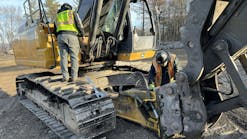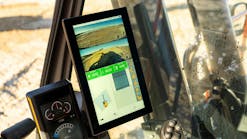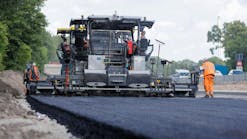Some companies in the construction industry may be reluctant to switch to digital, connected management software systems.
However, those who have are deriving a beneficial return on investment (ROI) as the software creates financial and time efficiencies from estimating to the competition of a job.
Editors note: This article originally ran in Grading & Excavation Contractor.
“Well-designed construction-specific management software can be a powerhouse for contractors that combine financial management, resource management, project management, HR management, and the ability to track and analyze data in real-time throughout the life cycle of each project,” notes Betsie Hoyt, former director, product management, Viewpoint (a Trimble Company).
Project status at all times
Management software enables project stakeholders to quickly and easily communicate and understand project status at all times, she adds.
“It should be complete with a support system that includes user training, user forums, and technical help as needed,” Hoyt says. “Construction management software is the glue that ties the project together.”
Site management software is becoming more mature and more commonplace, notes Patrick Stevenson, VP product management, Trimble.
“A connected solution can pay off before the project even begins,” he points out. “For instance, having accurate information at your fingertips to compare the original survey with the design gives you accurate cut/fill quantities and allows for better planning, scheduling and bidding.”
As the project commences, production data is automatically being captured and compared against the original ground and the constructible model, providing job progress information along the way.
As the project completes, the as-built information can be packaged up and shared with other systems for things like payment, quality reports, and asset management.
“Knowing in real-time what has been done and what is still to do streamlines the process for all stakeholders, allowing them to get it right the first time and move forward,” Stevenson adds.
Communication and tasks between diverse groups of workers on a project is always a challenge, especially when teams are dispersed across large geographic areas, Hoyt points out.
Streamline construction workflows
“Construction management software streamlines workflows and puts actionable information at users’ fingertips in real-time,” she adds. “The goal is to enable efficient communication that leads to productive decision-making, keeping the project on time and on budget.”
Case in point: an excavation project.
“In cut/fill scenarios, the amount of information needed to instruct a large number of operators – all with varying skill sets – can be overwhelming,” says Stevenson. “Having the latest instructions automatically distributed to their machine control-equipped machines ensures everyone is working against the same plan.”
When changes occur, updated designs are instantly transferred to the machines.
“Costly rework can be avoided as can time spent traveling between sites and machine idling,” Stevenson adds. “The remote insight into what is actually going on onsite and being able to compare progress-to-plan allows changes to be verified, catching issues as they arise and correcting them before it is too late.”
Contractors can save valuable time, significantly reduce costs and mitigate project errors and delays by eliminating double data entry from disconnected systems and manual processes, notes Hoyt.
“In addition, getting ahead of these issues with real-time, collaborative construction workflows can help reduce profit fade and add greater margins to companies’ bottom lines,” she adds.
Stevenson notes that keeping to schedule and budget is a main priority for construction operations, given the amount of time spent traveling between sites, fuel costs, machine idling, rework and delays, all of which affect the bottom line.
“Job site connectivity and monitoring tools offer a remote alternative to these issues, which is a particularly impactful benefit for construction companies that cover a large geographical area,” he adds.
Proper construction management software enables contractors to take quick action to modify plans and coordinate with field operations from anywhere in the world, avoiding costly mistakes where an outdated design or the wrong coordinate system is being used, says Stevenson.
“Site management software is fantastic for minimizing re-work,” he points out, adding he’s seen projects finish up to three times faster by just eliminating rework.
Trimble Viewpoint features a connected cloud construction management suite designed to seamlessly tie together contractors’ people, projects and processes through intuitive workflows.
The company focuses on enabling data and analytics in an easy-to-use format for contractors.
“Real-time data and analytic tools not only give contractors the ability to make smarter, actionable decisions, but they also empower users to more effectively predict future work, profit and project outcomes, allowing them to bid smarter and manage smarter,” says Hoyt.
Trimble’s range of construction management software solutions span the life cycle of a project from design and data prep to remote design transfer and live job site monitoring, notes Stevenson.
Stevenson advises that when choosing tools, it’s important for companies to consider their workflow in its entirety.
“You'll see the maximum impact when tools seamlessly pass information back and forth without complicated handoffs,” he says.
For example, Trimble WorksManager focuses on getting instructions out to the field for machine personnel and can be paired with the Trimble WorksOS site management tool that provides real-time visibility into the work being performed.
“Software needs to meet the needs of end-users and usability is a key component,” Hoyt points out, adding that Viewpoint regularly updates its software largely based on end-user feedback and research.
Hoyt says the software is designed for end users’ desires for simple navigation, automation, mobility and intuitive workflows.
The company also reviews usage metrics to ensure the software continues to meet those standards.
Operations can be complex, Stevenson adds.
“Trimble automates processes within existing workflows, streamlining data into actionable insights so users are as efficient as possible,” he says. “One example in Trimble WorksOS is the ability for a user to share dashboards they’ve created with other colleagues and avoid duplication of work.”
When adding the hidden costs to patch together stand-alone systems and manual processes to meet business needs, contractors are often surprised at their per-project cost, notes Hoyt.
“In many cases—particularly for mid- to large-sized contractors—this cost is as much as three times the cost of a more modern, cloud-based suite of connected construction solutions,” she adds.
“Contractors work with one software suite, one vendor and one set of data,” she adds. “As a bonus, moving to a hosted suite also removes the burden and capital asset expenses related to maintaining in-house servers, data storage and backups, data security, and regular software updates.”
Trimble’s construction management software solution end users have reported between 10 to 20 percent more efficiencies and project completions by up to three times faster, notes Stevenson.
“A huge benefit is simply transparency: everyone knows what work to do and what work has been completed,” he says.
B2W’s software is focused on improved operational workflows through five applications. (B2W Software)
Greg Norris, B2W Software spokesman, acknowledges that it can be challenging for some people to move from paper and spreadsheets to digital for managing job sites.
B2W Software’s heavy highway and civil construction software is focused on improved operational workflows through five applications: scheduling, dispatching, field tracking, equipment maintenance and electronic forms and reporting.
The applications are presented in a cohesive platform.
The construction industry is ramping up in terms of software deployment, so having a cohesive platform such as offered by B2W Software addresses the challenge of interoperability – getting different software platforms to ‘talk’ to each other, Norris points out.
B2W Schedule is the company’s newest product, replacing a previous product. It serves as an online scheduling and dispatching tool to replace whiteboards and spreadsheets that contractors typically use to schedule and dispatch their crews, employees, equipment and materials, notes Norris.
It replaces the "old-school" way of making a phone call or sending someone an email or text and is simultaneously visible in real-time to employees in the field, the shop and the office, he adds.
“There’s tremendous benefit in terms of resource optimization and resource efficiency in getting the right resources to the right place at the right time and knowing where your resources are going to be,” says Norris.
In using construction software from the start of a job to its completion, B2W end users start with the estimating product, which helps to enable them to cast a wide net to win more profitable bids, notes Norris.
The software includes pre-populated cost structures for accuracy and speed in bidding, enabling contractors to build bids more quickly, he adds.
The field tracking and scheduling applications are designed to help contractors’ staff and build the job in the field, helping to generate more workflow efficiencies.
“If you’re a foreman and you’re in the field and have a piece of equipment that needs to be repaired, you can make an immediate repair request in the field tracking software that becomes visible in the maintenance software,” says Norris.
“The maintenance manager can decide to send someone to fix it or bring it into the shop through real-time communication. Someone in the scheduling department can assign another piece of equipment while it's being repaired.”
Data drives decisions
Data further proves its usefulness by generating reports to make data-driven decisions, Norris adds.
For example, a contractor can see a machine’s repair history and use data to predict when the machine may go down. A history of safety incidents can be used to get predictive and preventative with safety.
The software goes a long way in improving communication among employees in the office and the field in creating real-time workflow efficiencies, which helps avoid errors or miscommunication, Norris points out.
The field-tracking software in particular enables supervisors and their crews to track the project status in contrast to where the estimate indicates the project should be.
That includes tracking performance, hours, materials and equipment utilization, with the data serving as a motivational factor, says Norris, adding there are no surprises in terms of being over or under budget and project hours.
The software also provides an opportunity to switch to a more proactive approach to equipment maintenance, Norris says.
“It’s less expensive to maintain a piece of equipment than to fix it when it breaks in most cases,” he adds. “Then there’s the added cost of job disruption and the cost of having to replace that with another piece of equipment or with rental fees.”
Payroll also benefits through a streamlined tracking of hours that is communicated directly to the accounting system, eliminating redundancies, Norris says.
Norris acknowledges the importance of ease of use for construction software, given that some companies are reticent to go digital.
“These systems aren’t being sold to IT professionals,” he points out. “They don't want their primary focus to be how to make the software work. We’ve focused on making it extremely intuitive and easy to use.
“That’s not just the interface, but the construction logic. We try to make the software work along with the same logic of doing things manually or with a spreadsheet would work and make it fit construction.”
B2W Software provides help to contractors in implementing the software, setting up the servers, cloud deployment, building databases as well as in-person training and online training, followed by support.
Norris says security protocols can be set up in the servers, with administrators determining who can have access to what data, including protecting proprietary information both internally and externally.
Using construction management software yields cost savings that are derived with accurate bids and maintenance cost savings, notes Norris.
“End users routinely tell us when they switch from spreadsheets to estimating software, they can do two to three times more estimates in addition to being more accurate or more confident,” Norris says. “They are getting two or three times what they were turning out when they had to rely on paper or Excel spreadsheets.”
Machine data for efficiencies
The latest John Deere software and technology, JDLink hardware and JDLink connectivity, “offers users the ability to tag machines into a group to track such factors as performance, utilization, and maintenance job site and not just by looking at individual machine data,” notes James Leibold, Product Manager – Connectivity, John Deere Construction and Forestry.
That gives end-users the ability to see what machines are being utilized and how and which ones may not be getting used efficiently than another job site could use more effectively, he adds.
The JDLink software is designed to provide the ability to better manage fleet optimization from start to finish of a job, or multiple jobs, remotely.
JDLink offers managers and foremen the freedom to monitor their machine operations, maintenance, and performance remotely using the JDLink web version or mobile app so they always have visibility of their entire fleet at their fingertips, notes Leibold.
The JDLink software provides customers with real-time access to engine systems, equipment utilization, and fuel consumption.
Automatic email notifications and alerts can be set for machine maintenance, trouble codes, or even if a machine leaves a pre-determined boundary, says Leibold.
“This ensures a contractor is always aware of the current state of a job site and has access to comparative data to other job sites to highlight cost-saving opportunities like operator coaching or better utilizing fuel-saving features like Eco Mode,” he adds.
John Deere recently announced the latest software package for wheel loaders, Asset Recognition.
The software is designed to allow operators to switch between attachments and have those attachments automatically connect to the machine and change hydraulic settings to ensure the attachment is properly configured without constantly changing the settings manually, notes Leibold.
John Deere’s software is designed with a landing page that offers the desired data right away with descriptive dropdowns for a deeper dive into the data, notes Leibold.
John Deere recently announced that its JDLink telematics will no longer require subscriptions, renewal dates, or any fees to connect to its web or mobile app.
“This can contribute to higher ROI now that end users can understand, plan, and monitor job sites performance with no additional fees or costly subscription costs,” says Leibold.





